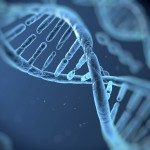Lien vers Pubmed [PMID] – 22678063
Hum. Mol. Genet. 2012 Sep;21(17):3835-44
We report a consanguineous Iranian family affected by congenital profound sensorineural deafness segregating in an autosomal recessive mode. Auditory tests implicated at least a cochlear defect in these patients. We mapped the deafness, autosomal recessive (DFNB) locus involved by linkage analysis to a 4.8 Mb region at chromosome 21q22.3-qter. Exclusion of the DFNB8/10 gene TMPRSS3, located in this chromosomal interval, led us to identify a new deafness locus, DFNB98. Whole exome sequencing allowed us to identify a homozygous frame-shifting mutation (c.1726G>T+c.1728delC) in the gene TSPEAR (thrombospondin-type laminin G domain and EAR repeats). This truncating mutation (p.V576LfsX37) impeded the secretion of the encoded protein by cells transfected with the mutated gene. Alternative splicing of TSPEAR transcripts predict two protein isoforms, 522 and 669 amino acids in length, both of which would be affected by the mutation. These isoforms are composed of a thrombospondin-type laminin G (TSP) domain followed by seven tandemly organized epilepsy-associated repeats (EARs), probably forming a β-propeller domain. Tspear is expressed in a variety of murine tissues. Only the larger Tspear transcript was found in the cochlea, and the protein was detected by immunofluorescence at the surface of the hair bundles of sensory cells. The mammalian EAR protein family includes six known members. Defects in four of them, i.e. Lgi1, Lgi2, Vlgr1 and, we show here, TSPEAR, cause disorders with auditory features: epilepsy, which can include auditory features in humans; audiogenic seizures in animals; and/or hearing impairments in humans and mice. These observations demonstrate that EAR-containing proteins are essential for the development and function of the auditory system.

